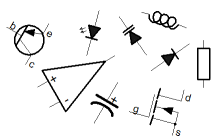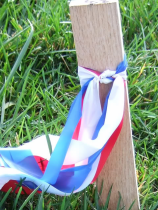 |
 |
 |
 |
 |
 |
 |
|
Design Synthesis
Now we have an overview for the complete reciever we can begin to look at the circuit design aspects. Although the system diagram does not attempt to say how individual functions of the receiver should be implemented, it is very important. In some cases, the design will be small, or perhaps quite conventional. In these cases it is not critical that a system diagram is produced, but it is always important to have at least some overall idea of direction. As we now dig into the electronics design, it will become apparent how, although the functional blocks are descrete, their behaviours will inevitably be interrelated. Individual functional blocks may be difficult to develop in isolation. It may be undesirable to stick rigidly to the system overview compartments. Importantly the sytstem overview implements a framework, in which the design can develop and grow. Starting pointPerhaps the most important function in the receiver is the front end, the first stage of amplification after the antenna. This is where the signal of interest is the smallest, and the biggest effort must be made to maintain signal integrity. On that basis and reasoning, perhaps more important is the Antenna. The problem with the antenna design is that we are uncertain about the energy density of the signal in proximity to the receiver. Also, the wavelength of the MSF signal is very great. At 60kHz the signal from Anthorn is 5km, really quite long. If we were to build a conventional Hertzian dipole for this signal it would need to be at least that sort of size to receive a good signal. When taken together, it is easy to see that the best approach for the Antenna design is to use a ferrite rod and a loop or coil. The significant benefit is that the loop antenna can be made physically small, and still receive a reasonable signal. In conjunction with the ferrite rod, it's performance can be reasonable in a very small package. The problem, however, with this kind of design is that it is unpredictable. The loop antenna is highly directional, and importantly, is greatly affected by the use of the ferrite rod. The exact performance of the Antenna is affected mainly by the material composition of the ferrite, and it's execptionally difficult to be precise about that. Because we don't know what sort of signal power we'll get from the antenna, or for that matter, what sort of selectivity we'll get, the front end design will need to remain "loose". In the spec I've already said that the antenna will need to be separate, for optimal positioning. In the limit, that could mean 10 meters of cabling between the antenna and the receiver. At that end of the scale, I'm thinking that the antenna might need to be "active". In the simplest possible terms we need some degree of flexibility on the receiver circuit board to accomodate a transistor amplifier near the antenna. In addition we may need extra selectivity. Just got to drive the stake into the ground"It doesn't even matter if you have to move it later!"
For the time being, and for the prototype, we'll consider the idea that the front end of the receiver will be an amplifier. We'll allow for additional decoupling and a spare filter right up front so that we can attach additional amplification on the front if we need it. Exactly what form that will take will come later, but it's left open here, to get it out of the way early! The simple utility of this approach is to get as much as we think we'll need, on the board as possible. Strapping out unwanted capacitors and inductors is easy. I've already shared the idea that my aim is to make the receiver out of generic parts, in particular, op-amps. We're all of our time, and the TL081 certainly shows mine. Irrespective, the TL081 remains my first choice op-amp for most general purpose applications. It's got a JFET input and a Bipolar output. It's distinctly cheap, and comes in a wide range of environmental capabilities and packages. It's not likely to become obsolete any time soon. What's not to like? Although the TL081 has a JFET input, which is good for maintaining a high input impedance, it suffers the same input offset problems that most linear op-amps do. The input offsets of the TL081 are between 8 and 13mV. We're looking at the signal coming from the antenna being unknown, but referring back to the RF spec we decided that we might nominally expect to be working with a 40nV signal. Clearly the TL081 isn't going to cut it. Fortunately, the gain bandwidth product of the TL081 is 3MHz, at 60KHz this corresponds to a gain of 50. Although it's not great, if we can make the signal bigger than these offsets, we're into a world where the TL081 is useful and makes sense. Since we're looking at working with these tiny signals, it's unrealistic to expect that we're going to find an op-amp that can help us. When all else fails, it's back to transistors! In this application most small signal transistors are likely to do a stirling job. Unencumbered with the requirement of a closed loop, and the need to achieve stability, a typical small signal transistor will achieve a bandwidth of 300MHz, a maximum voltage between the collector and the emitter of around 20V, and a current gain of 150. Personally I favour the 2N3904 and the 2N3906 which are pretty commonplace and reasonably cheap, like the TL081. They make a nice complimentary pair, being similar in package and general parameters, particularly gain. The 2N3904 is NPN, the 2N3906 PNP. So, that's it then, the stake is in the ground. In this case, it's kind of easy, because I can see a way to do what I need with components that I can imagine in my head. Often it's more complex, but we'll see more of that later. Some people say that finding semiconductors is really hard. I'm not sure about that myself. For me I'd say that finding semiconductors is the easy part. They're usually pretty well documented; if they weren't they'd be almost unusable. Personally I find speciality analogue components the hardest to get right. Probably the worst are inductors and transformers - wound components. Such components as inductors are less commonly used, for one thing. They're more likely to be customised for a large run of power supplies. If they're widely used ort well documented they'll be for line driving applciations - telecommunications. Tuned inductors, multi winding transformers, and loop antennas, are always beautiful simple solutions. If you can get them off the shelf, they're often made by companies that are more mechanical engineering oriented than electronics. Getting the data you want is really quite difficult. It's not that their manufacturers are being unhelpful, as mechanical engineers perhaps they just don't know. Even if they did, they can hardly predict some wierd application and give you the data you need. We're going to need some inductors, so we'll be coving that one. Finally for this page, we'll consider our standard decoupling capacitor. It's particularly important for this design, because we'll be building a single sided board. We'll nominally use a 100nF polyester film capacitor. This will have broadly acceptable capabilities in a standard sized package. The tolerance will be nominally 10%, and the working voltage will be greater than 50Vdc. Typically this kind of capacitor is cheaper than a chip! |
Copyright © Solid Fluid 2007-2025 |
Last modified: SolFlu Sat, 19 Nov 2011 00:56:56 GMT |

